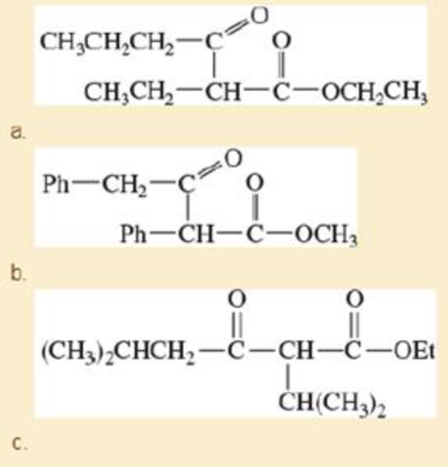
EP ORGANIC CHEMISTRY -MOD.MASTERING 18W
9th Edition
ISBN: 9780136781776
Author: Wade
Publisher: PEARSON CO
expand_more
expand_more
format_list_bulleted
Concept explainers
Textbook Question
Chapter 22.12, Problem 22.38P
Show what esters would undergo Claisen condensation to give the following β – keto ester.

Expert Solution & Answer
Want to see the full answer?
Check out a sample textbook solution
Students have asked these similar questions
Apply the NANSTE law to the MnO4- + 8H+ + 5e- ⇄ Mn2+ + 4H2O
In the Nernst Law, how much is RT / F?
Hi can you please help me solve these problems? thank you
Chapter 22 Solutions
EP ORGANIC CHEMISTRY -MOD.MASTERING 18W
Ch. 22.2A - Prob. 22.2PCh. 22.4 - Without looking back, propose a mechanism for the...Ch. 22.4 - Prob. 22.8PCh. 22.4 - Prob. 22.9PCh. 22.5A - Prob. 22.10PCh. 22.5A - Prob. 22.11PCh. 22.5B - Prob. 22.12PCh. 22.5B - Predict the products of the following reactions....Ch. 22.5B - Which compounds will give positive iodoform tests?...Ch. 22.5C - Propose a mechanism for the acid-catalyzed...
Ch. 22.5C - Acid-catalyzed halogenation is synthetically...Ch. 22.6 - Show the products of the reactions of these...Ch. 22.7A - Prob. 22.18PCh. 22.7A - Prob. 22.19PCh. 22.7A - Prob. 22.20PCh. 22.7B - Prob. 22.21PCh. 22.8 - Prob. 22.22PCh. 22.8 - Prob. 22.24PCh. 22.9 - Prob. 22.25PCh. 22.9 - Prob. 22.26PCh. 22.9 - Prob. 22.27PCh. 22.9 - Prob. 22.28PCh. 22.9 - Prob. 22.29PCh. 22.10 - When cyclodecane-1,6-dione is treated with sodium...Ch. 22.11 - Prob. 22.32PCh. 22.11 - Prob. 22.33PCh. 22.12 - Prob. 22.34PCh. 22.12 - Prob. 22.35PCh. 22.12 - Prob. 22.36PCh. 22.12 - Prob. 22.37PCh. 22.12 - Show what esters would undergo Claisen...Ch. 22.13 - Prob. 22.39PCh. 22.13 - Prob. 22.40PCh. 22.14 - Prob. 22.41PCh. 22.14 - Prob. 22.42PCh. 22.14 - Show how crossed Claisen condensations could be...Ch. 22.14 - Prob. 22.44PCh. 22.14 - Prob. 22.45PCh. 22.15 - Prob. 22.46PCh. 22.16 - Prob. 22.47PCh. 22.16 - Prob. 22.48PCh. 22.17 - Prob. 22.49PCh. 22.17 - Prob. 22.50PCh. 22.17 - Prob. 22.51PCh. 22.18 - Prob. 22.52PCh. 22.18 - Prob. 22.53PCh. 22.18 - Prob. 22.54PCh. 22.18 - Prob. 22.55PCh. 22.18 - Prob. 22.56PCh. 22.19 - Prob. 22.57PCh. 22.19 - Prob. 22.58PCh. 22.19 - Prob. 22.59PCh. 22 - Prob. 22.60SPCh. 22 - 1. Rank the following compounds in order of...Ch. 22 - Prob. 22.62SPCh. 22 - Prob. 22.63SPCh. 22 - Prob. 22.64SPCh. 22 - Pentane-2,4-dione (acetylacetone) exists as a...Ch. 22 - a. Rank these compounds in order of increasing...Ch. 22 - Prob. 22.67SPCh. 22 - Prob. 22.68SPCh. 22 - 22-69 Predict the products of the following...Ch. 22 - Predict the products of these reaction sequences.Ch. 22 - Show how you would accomplish the following...Ch. 22 - Prob. 22.72SPCh. 22 - Prob. 22.73SPCh. 22 - Prob. 22.74SPCh. 22 - The Knoevenagel condensation is a special case of...Ch. 22 - Prob. 22.76SPCh. 22 - Propose mechanisms for the following reactions.Ch. 22 - Prob. 22.78SPCh. 22 - Show how you would accomplish the following...Ch. 22 - Prob. 22.80SPCh. 22 - Propose a mechanism for the following reaction....Ch. 22 - Prob. 22.83SPCh. 22 - Prob. 22.84SPCh. 22 - Prob. 22.85SP
Knowledge Booster
Learn more about
Need a deep-dive on the concept behind this application? Look no further. Learn more about this topic, chemistry and related others by exploring similar questions and additional content below.Similar questions
- Hi can you please help me solve this problem? thank youarrow_forwardAn electrode process takes place at a metal-solution interface. Indicate the current condition that must be met for Faradaic rectification to occur.arrow_forwardAt a metal-solution interface, an electron is exchanged, and the symmetry factor beta < 0.5 is found in the Butler-Volmer equation. What does this indicate?arrow_forward
- Please do these questions within the SCH4U course please with full steps since I am still unsure how to format my answers! Thank you so much.arrow_forwardWhen two solutions, one of 0.1 M KCl (I) and the other of 0.1 M MCl (II), are brought into contact by a membrane. The cation M cannot cross the membrane. At equilibrium, x moles of K+ will have passed from solution (I) to (II). To maintain the neutrality of the two solutions, x moles of Cl- will also have to pass from I to II. Explain this equality: (0.1 - x)/x = (0.1 + x)/(0.1 - x)arrow_forwardCalculate the variation in the potential of the Pt/MnO4-, Mn2+ pair with pH, indicating the value of the standard potential. Data: E0 = 1.12.arrow_forward
arrow_back_ios
SEE MORE QUESTIONS
arrow_forward_ios
Recommended textbooks for you
 Organic ChemistryChemistryISBN:9781305580350Author:William H. Brown, Brent L. Iverson, Eric Anslyn, Christopher S. FootePublisher:Cengage Learning
Organic ChemistryChemistryISBN:9781305580350Author:William H. Brown, Brent L. Iverson, Eric Anslyn, Christopher S. FootePublisher:Cengage Learning
 EBK A SMALL SCALE APPROACH TO ORGANIC LChemistryISBN:9781305446021Author:LampmanPublisher:CENGAGE LEARNING - CONSIGNMENT
EBK A SMALL SCALE APPROACH TO ORGANIC LChemistryISBN:9781305446021Author:LampmanPublisher:CENGAGE LEARNING - CONSIGNMENT

Organic Chemistry
Chemistry
ISBN:9781305580350
Author:William H. Brown, Brent L. Iverson, Eric Anslyn, Christopher S. Foote
Publisher:Cengage Learning


EBK A SMALL SCALE APPROACH TO ORGANIC L
Chemistry
ISBN:9781305446021
Author:Lampman
Publisher:CENGAGE LEARNING - CONSIGNMENT
Enzymes - Effect of cofactors on enzyme; Author: Tutorials Point (India) Ltd;https://www.youtube.com/watch?v=AkAbIwxyUs4;License: Standard YouTube License, CC-BY
Enzyme Catalysis Part-I; Author: NPTEL-NOC IITM;https://www.youtube.com/watch?v=aZE740JWZuQ;License: Standard Youtube License